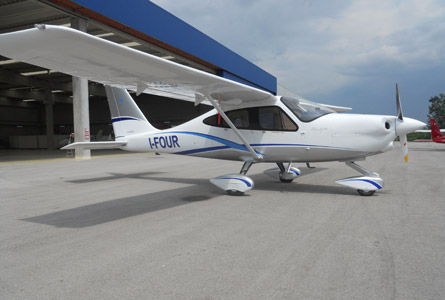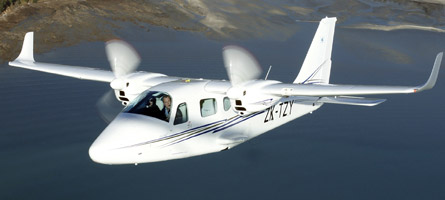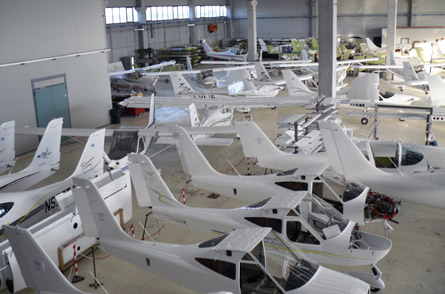These are challenging times for Europe's general aviation aircraft manufacturing industry. Economic fragility has led to falling demand and dwindling sales on the continent and beyond, and many companies - particularly those with a limited product lines - are struggling to keep afloat.
For Italian airframer Tecnam, its broad and extensive product line, which includes certified twin and single engines, light sport aircraft (LSA) and advanced ultra lights, has helped to shield it from the financial tsunami that has swept the western world. The company, based in Capua, near Naples, is now the largest producer of LSAs globally.
 |
|---|
© Tecnam The P2010, debuted last year, was Tecnam's first four-seat piston single |
Tecnam's dominance in the light general aviation market is perhaps no surprise, given its illustrious pedigree. Established in 1986, the airframer traces its roots back to brothers Luigi and Giovanni Pascale, who developed and produced a series of innovative aircraft soon after the end of World War II, such as the P48 Astore. The brothers founded Partenvia (now Vulcanair) and continued to create original models, such as the P68 under this brand name. The Tecnam stable has continued to create a host of best-selling aircraft, from the P2008 ultralight to the P2006 twin - which is also available in airborne-surveillance and multimission configurations.
"My father and my uncle developed a passion for flying and designing aircraft after the second world war and that passion continues with Tecnam today," Tecnam's managing director Paolo Pascale says.
Tecnam started life as a parts subcontractor to the major airframers including ATR, Boeing and Alenia Aermacchi and returned to aircraft building in 1991, Pascale says. Today the company produces 15 models and has a global fleet of 3,500 aircraft. Since early 2011, five new models have been launched including three versions of the ubiquitous P92 light piston, now in its sixth generation.
The P92 Eaglet LY light sport aircraft, unveiled a year ago, offers a wider cabin and a more powerful 115hp (86kW) Lycoming IO-233 B2A engine than its predecessors. Launch of the €68,800 ($90,000) aircraft was followed, in late 2011, by the first flight of the P92TD. This tail-dragger variant of piston single is powered by either the Rotax 912ULS2, 914 Turbo (for customers outside the USA) and the Lycoming 0-233. Service entry is planned this year.
 |
|---|
© Tecnam P2006 twin sales helped to mitigate the downturn's impact |
January saw the launch of the P-92 seaplane. The float-equipped aircraft - dubbed the Sea-Sky Hydroplane - has a take-off run of less than 200m and can operate from water, be it lakes, rivers or sea, Pascale says.
In 2011, Tecnam also launched its first four-seat piston single. Called the P2010, the Lycoming IO-360MIA aircraft has a carbon fibre fuselage and a metal wing and is designed to fill a gap in Tecnam's predominantly two-seat single-engine family. "We have two-seat singles and a four-seat twin in our line-up, but a four-seat single was missing," Pascale says. The €182,000 aircraft is targeted at the training and owner-flyer markets. Certification and service entry are scheduled for later this year.
NEW NICHE
The fifth new aircraft was perhaps the most surprising of all, admits Pascale. The 11-seat, P2012 Traveller shifted Tecnam out of its light-aircraft comfort zone into the established commuter airline sector. "The P2012 piston twin is a departure for Tecnam," Pascale admits. "Our line-up comprises mainly light-aircraft designs targeted at owner-flyers and flying schools, but we saw a niche in the market and had to fill it."
Tecnam has partnered US carrier Cape Air to bring the product to fruition. The operator, based in Hyannis, Massachusetts, is the largest commuter airline in the USA, with a fleet of 67 Cessna 402s and Piper Navajos, and two ATR 42s.
"There is an urgent requirement for a new nine-passenger commuter aircraft in this market - no [Federal Aviation Regulation Part 23 aircraft] has been produced for this sector for about 25 years," Pacale says.
Tecnam is close to freezing the aircraft's design and plans in a couple of months to start producing parts for the first prototype, which should make its first flight 18 months later. It targets a total market of 1,500 aircraft as replacements for 402s and Navajos, of which it expects to secure one-third. Cargo, parachute and medevac versions are also planned. "The cabin is not pressurised and is ideal for short legs of up to 1hr 30mins at low altitude," Pacale says.
The turbocharged, avgas and mogas-fuelled Lycoming TEO-540-powered aircraft is priced between €1.5 million ($2.17 million) and €1.8 million. It has a fixed gear, "allowing it to operate from unpaved runways", Pascale adds, and large panoramic windows and four doors, including a sliding passenger door. The Traveller is designed to provide a maximum cruise speed of 215kt (400km/h) at 10,000ft (3,000m) and a long-range cruise speed of 170kt.
Tecnam's focus will continue to be on upgrading its product line, Pascale says. He suggests there are no niches in the GA market that the company is seeking to explore.
ECONOMIC IMPACT
The economic downturn has affected Tecnam's sales, but the company's broad product line and predominantly global customer base has helped to soften the financial blow. In 2010 Tecnam delivered around 300 aircraft; this number fell to around 270 last year. It is unclear what the 2012 delivery tally is expected to be, but Pascale remains confident it will "close a number of sales" to private flyers and training schools.
"We are committed to building up our service centre and support network globally," Pascale says. Tecnam has around 50 dealers worldwide, including in the UK, Australia and the USA, where it is particularly keen to strengthen its presence.
"The USA is the birthplace of general aviation and there is great potential for the Tecnam range here, particularly from flight schools."
 |
|---|
© Tecnam Tecnam produces 15 models and has a global fleet of 3,500 aircraft |
He admits the launch of the P2012 has given the company the impetus to expand its offering. "The Traveller has opened up a new market for Tecnam and these customers demands a different level of service [than traditional owner-flyers and schools]," Pascale says.
Part of Tecnam's plans for the USA includes an assembly base "in the not too distant future". Pascale says: "If you want to capture the US market you have to be present there," he adds.
Tecnam has a base in Capua, home to the single and twin-engined aircraft lines, and in Casoria, which houses composite and carbon fibre parts manufacture. "We had a base in Spain but decided to bring all manufacturing in house two years ago. It was too complicated to manage and there were issues with the skill base," he adds.
Europe accounts for the largest concentration of the Tecnam fleet with France, Spain, Germany and Italy home to the largest installed base. The region's fragile economies and sovereign debt crises have, however, affected heavily new aircraft sales over the past three years. "GA in Europe is dead, dead, dead," Pascale concedes.
The airframer's home market of Italy has been hard hit by the recent change of administration. "The new government is trying to get money from wherever they can and have applied higher taxes to the aviation industry," Pascale says.
Traditional light general aviation aircraft have become expensive to buy and fly, and many are turning to LSAs and ultralights as cheaper alternatives. But Pascale maintains they are well positioned in these sectors having marketed their products worldwide in Brazil, Australia, New Zealand and Russia.
Source: Flight International
















